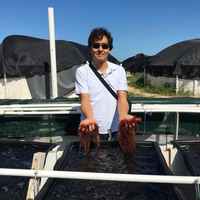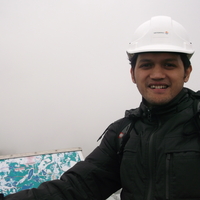
Patrick White
Research and consultancy on ecosystem approach to aquaculture, site selection, assessment and sustainable carrying capacity estimation, the impact of Climate Change on aquaculture
less
Related Authors
Julian D Reynolds
Trinity College Dublin
Estella Weiss-Krejci
Austrian Academy of Sciences
Daniel Robledo
Centro de Investigacion y Estudios Avanzados del IPN
Armando Marques-Guedes
UNL - New University of Lisbon
Noe Cornago
University of the Basque Country, Euskal Herriko Unibertsitatea
Carlos Garcia de Leaniz
Swansea University
Simon Springer
The University of Newcastle
Camelia Dewan, PhD
University of Oslo
Muhammad Sonny Abfertiawan
Institut Teknologi Bandung
Timothy Morton
Rice University
InterestsView All (14)










Uploads
Papers by Patrick White
but on the contrary, the additional nutrients from the feed may have a beneficial effect, boosting natural productivity including fisheries. The important components of fish farming waste comprise nutrients (dissolved and particulate) resulting from the metabolism of fish food, uneaten food, escapees of farmed fish affecting the genetic diversity of wild fish populations and chemical residues of disease or parasitic therapeutant treatments. Potential management measures to mitigate environmental impacts include public and private sector approaches. The public sector approaches include appropriate and specific aquaculture policies, strategies, regulations, legislation, and management plans, adoption and implementation of the FAO Code of Conduct for Responsible Fisheries (CCRF) and Ecosystem Approach to Aquaculture (EAA) strategies for planning, management, monitoring, and control. Zoning for aquaculture space is to be based on the allocation of aquafarms on suitable areas, appropriate evaluation of carrying capacity of the ecosystem, planning and management for disease prevention and treatment and environmental control. Appropriate control of farm permits, licences, and registration by
the state is necessary to monitor and control aquaculture development. The private sector approaches include improved feed formulation and feeding strategies to reduce the feed conversion ratio and nutrient losses, the use of Integrated Multi-trophic Aquaculture (IMTA) to utilise nutrient outputs from intensive aquaculture and thus regular environmental monitoring is the key to ensure that impacts remain within acceptable limits. (Key words: Aquaculture certification, Aquaculture impacts, Better management practices, Environmental management, Fish cage culture, Integrated multi-trophic aquaculture).
but on the contrary, the additional nutrients from the feed may have a beneficial effect, boosting natural productivity including fisheries. The important components of fish farming waste comprise nutrients (dissolved and particulate) resulting from the metabolism of fish food, uneaten food, escapees of farmed fish affecting the genetic diversity of wild fish populations and chemical residues of disease or parasitic therapeutant treatments. Potential management measures to mitigate environmental impacts include public and private sector approaches. The public sector approaches include appropriate and specific aquaculture policies, strategies, regulations, legislation, and management plans, adoption and implementation of the FAO Code of Conduct for Responsible Fisheries (CCRF) and Ecosystem Approach to Aquaculture (EAA) strategies for planning, management, monitoring, and control. Zoning for aquaculture space is to be based on the allocation of aquafarms on suitable areas, appropriate evaluation of carrying capacity of the ecosystem, planning and management for disease prevention and treatment and environmental control. Appropriate control of farm permits, licences, and registration by
the state is necessary to monitor and control aquaculture development. The private sector approaches include improved feed formulation and feeding strategies to reduce the feed conversion ratio and nutrient losses, the use of Integrated Multi-trophic Aquaculture (IMTA) to utilise nutrient outputs from intensive aquaculture and thus regular environmental monitoring is the key to ensure that impacts remain within acceptable limits. (Key words: Aquaculture certification, Aquaculture impacts, Better management practices, Environmental management, Fish cage culture, Integrated multi-trophic aquaculture).
The increasing pressure on the use of coastal zones from alternative activities such as tourism and urban development provides strong impetus to move mariculture activities into offshore waters. The expansion of mariculture to more exposed waters off the coast is more challenging from a technological, environmental and logistical viewpoint. In general, the greater the distance offshore that a mariculture activity is located, in deeper waters and in areas with an increased degree to weather exposure, the higher the complexity of technology that will be required, along with greater capital investments.
It is important to establish a regulatory process that clearly identifies where cage culture facilities can be located and for how long. Investors need to be confident that they will be allowed to operate in a location for sufficient time to get a profitable return on their investment. The investor should have a legal right to remain at the land or sea site (say for a renewable 20 year lease) and a legal permit to operate that is respected by other Ministries.
Good planning practices include zoning, carrying capacity estimation, Environmental Impact Assessments (EIAs), and permitting or licensing with a cap on production. There are a number of tools (such as geographic information system, carrying capacity models, environmental impact models) that can assist decision making for identification of aquaculture zones, farm site selection, and impact modelling for aquaculture development and management. Modelling the nutrient budgets for individual farms helps to prevent local impact. Modelling clusters of farms helps prevent more widespread impact in water bodies and could help find the optimal balance of nutrient release to minimize impacts on fisheries or even to enhance primary productivity in support of wild fisheries.
This paper describes some of the good practices for responsible aquaculture planning and sustainable management of the sector.
Fish cages vary in design, size and materials used as they are intended for diverse environments, ranging from relatively protected to highly exposed and dynamic sites, either as floating or submerged underwater structures and adopting a number of technological solutions to facilitate fish stock husbandry and management.
The future prospects for all forms of cage farming look relatively bright for Asia. The technology and business model for large scale cage farming have been developed by the vertically integrated marine cage farming companies in northern Europe (e.g. Norway) and South America (e.g. Chile). The development of large scale offshore cage farming in Asia is presently hampered by availability of capital and the hydrography of the surrounding seas, which does not allow the offshore salmon cage farming technology to be easily transferred.
This paper describes some of the aspects that investors should consider when setting up a large scale fish cage farm.
Fish cages vary in design, size and materials used as they are intended for diverse environments, ranging from relatively protected to highly exposed and dynamic sites, either as floating or submerged underwater structures and adopting a number of technological solutions to facilitate fish stock husbandry and management.
The future prospects for all forms of cage farming look relatively bright for Asia. The technology and business model for large scale cage farming have been developed by the vertically integrated marine cage farming companies in northern Europe (e.g. Norway) and South America (e.g. Chile). The development of large scale offshore cage farming in Asia is presently hampered by availability of capital and the hydrography of the surrounding seas, which does not allow the offshore salmon cage farming technology to be easily transferred.
It is important to establish a regulatory process that clearly identifies where cage culture facilities can be located and for how long. Investors need to be confident that they will be allowed to operate in a location for sufficient time to get a profitable return on their investment.
Good planning practices include zoning, carrying capacity estimation, Environmental Impact Assessments (EIAs), and permitting or licensing with a cap on production. There are a number of tools (such as geographic information system, carrying capacity models, environmental impact models) that can assist decision making for identification of aquaculture zones, farm site selection, and impact modelling for aquaculture development and management.